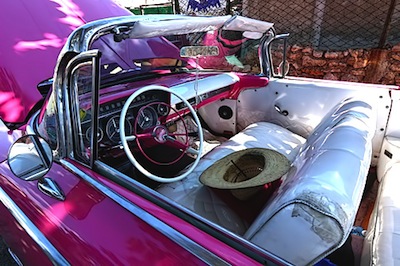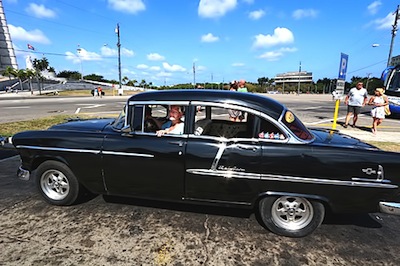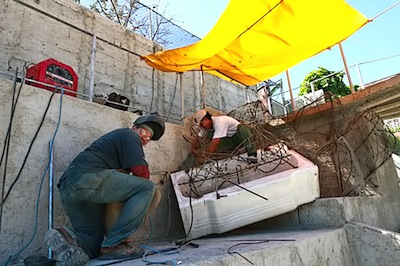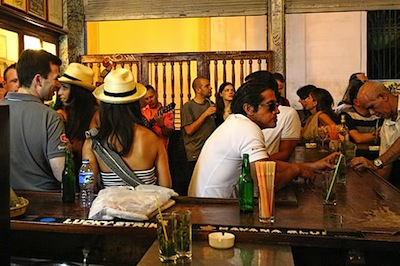 I stepped from the dimly lit terminal into the parking lot at at Havana International Airport. Blinking to let my eyes adjust to the brilliant sunshine, I marveled at row upon row of classic cars, their rounded silhouettes a chorus line of humpback whales. I knew about Cuba’s classic cars, but had not expected to see so many. On the broad boulevards, our tour bus was surrounded by 1950’s era Cadillacs with gleaming chrome grilles and ostentatious fins, painted in gaudy colors designed to make the most ambivalent pedestrian take notice. It was just the first of many surprises during my eight-day tour of Cuba with Discover Corps.
I stepped from the dimly lit terminal into the parking lot at at Havana International Airport. Blinking to let my eyes adjust to the brilliant sunshine, I marveled at row upon row of classic cars, their rounded silhouettes a chorus line of humpback whales. I knew about Cuba’s classic cars, but had not expected to see so many. On the broad boulevards, our tour bus was surrounded by 1950’s era Cadillacs with gleaming chrome grilles and ostentatious fins, painted in gaudy colors designed to make the most ambivalent pedestrian take notice. It was just the first of many surprises during my eight-day tour of Cuba with Discover Corps.
A short while later I got up close and personal with one of those classics at Revolution Square, a 1957 Chevy Bel Air taxi, its black paint polished to a mirror surface. The driver lit up when he learned I was from the U.S.. “Can Americans travel to Cuba now?” he asked excitedly. I explained that American citizens are allowed to travel to Cuba on people-to-people cultural exchange tours that are approved by our State Department, but added that restrictions were gradually easing and I felt sure that free travel between our two countries would soon be allowed. “I hope so. We want you – no, we NEED you!” Despite having suffered for decades under the embargo imposed by the U.S. government, Cubans welcome Americans with open arms, and my friendly taxi driver was no exception. When I raised my camera to take a photo of his car, he stopped me, insisting that I allow him to take a photo of me sitting behind the wheel.
 People-to-people tours are required to create itineraries that provide interaction with Cubans in order to learn about their culture and, conversely, to provide Cubans an opportunity to learn about the American way of life. As a result, my tour prohibited us from visiting Cuba’s reputedly gorgeous beaches. Instead, it focused on music, dance, art, education, and food. We met with an economics professor from the University of Havana, who revealed startling information about the extent to which the U.S. government has meddled in the Cuban economy. Another day we visited a polyclinic, where doctors and nurses discussed the Cuban health care system, reputed to be one of the best in the world. We were all surprised to learn that Cuba has one of the lowest infant mortality rates in the world, far better than that of the U.S.
People-to-people tours are required to create itineraries that provide interaction with Cubans in order to learn about their culture and, conversely, to provide Cubans an opportunity to learn about the American way of life. As a result, my tour prohibited us from visiting Cuba’s reputedly gorgeous beaches. Instead, it focused on music, dance, art, education, and food. We met with an economics professor from the University of Havana, who revealed startling information about the extent to which the U.S. government has meddled in the Cuban economy. Another day we visited a polyclinic, where doctors and nurses discussed the Cuban health care system, reputed to be one of the best in the world. We were all surprised to learn that Cuba has one of the lowest infant mortality rates in the world, far better than that of the U.S.
Per the Cuban Constitution of 1976, all Cuban citizens are guaranteed the right to free education and free health care
Providing free education and health care for all Cubans takes 70% of the government’s annual budget and much of the remainder is used to subsidize housing and food. With precious little funding available for other social programs, the arts have stepped in to fill the gap. Habana Compas Dance is among the non-profit organizations in Havana hoping to effect change. Focusing on Afro-Cuban heritage, they teach percussion and performance art to more than 400 inner-city kids. I sat spellbound as the dance troupe beat out rhythms with drumsticks on wooden chairs, accompanied by bata and conga drums.
In a suburb of Havana, where the attitude was once “every man for himself,” another art-based group, Muraleando, has used mural-painting classes to foster a new-found sense of community pride. Not only do murals now cover the walls around the neighborhood, sculptures have been created from the piles of trash that used to litter the streets and empty lots.
 If art is the backbone of Cuba, music and dance are its heart and soul. After dinner one evening, I picked my way over cobblestone streets, searching for the source of music that echoed through the narrow lanes of Old Havana. Not far from Cathedral Square I found La Bodeguita del Medio, a bar and restaurant that Ernest Hemingway frequented for their famous Mojito cocktails. The ebony doorman smiled, his pearly whites glowing like a giant Cheshire cat in the dimly lit street, and waved me inside. I shouldered through the crowd to the back bar, where I caught a glimpse of the live trio set up in one corner. All across Havana, music seemed to offer a respite from the harsh reality of everyday life. Salsa (Son) clubs dotted the broad boulevards and nightclubs featured live jazz bands. Folk musicians sang in public squares and stilt walkers sashayed down streets to the rhythm of the conga. In Cienfuegos, a performance by the Cienfuegos Chorus brought me to tears when they broke out in a spine-tingling rendition of Shenandoah.
If art is the backbone of Cuba, music and dance are its heart and soul. After dinner one evening, I picked my way over cobblestone streets, searching for the source of music that echoed through the narrow lanes of Old Havana. Not far from Cathedral Square I found La Bodeguita del Medio, a bar and restaurant that Ernest Hemingway frequented for their famous Mojito cocktails. The ebony doorman smiled, his pearly whites glowing like a giant Cheshire cat in the dimly lit street, and waved me inside. I shouldered through the crowd to the back bar, where I caught a glimpse of the live trio set up in one corner. All across Havana, music seemed to offer a respite from the harsh reality of everyday life. Salsa (Son) clubs dotted the broad boulevards and nightclubs featured live jazz bands. Folk musicians sang in public squares and stilt walkers sashayed down streets to the rhythm of the conga. In Cienfuegos, a performance by the Cienfuegos Chorus brought me to tears when they broke out in a spine-tingling rendition of Shenandoah.
 For many years I considered traveling to Cuba illegally via Canada or Mexico, but chose not to because I would not have been able to write about my experience, nor did I wish to risk prosecution. This intriguing island, located just 90 miles south of Key West, Florida, remained forbidden fruit. My lifelong dream of visiting Cuba finally became a reality when, in January 2015, President Obama eased restrictions on travel to Cuba and I joined the Building Bridges tour with Discover Corps. Once all Americans are allowed to travel freely to Cuba, more than a million of us are expected to do so each year. It remains to be seen what impact this massive increase in tourism will have. Will the classic cars gradually disappear? Will the welcoming attitude of Cubans become a tad less enthusiastic as an already strained infrastructure is tested? No one knows for sure, but it is safe to say that it is better to go sooner rather than later.
For many years I considered traveling to Cuba illegally via Canada or Mexico, but chose not to because I would not have been able to write about my experience, nor did I wish to risk prosecution. This intriguing island, located just 90 miles south of Key West, Florida, remained forbidden fruit. My lifelong dream of visiting Cuba finally became a reality when, in January 2015, President Obama eased restrictions on travel to Cuba and I joined the Building Bridges tour with Discover Corps. Once all Americans are allowed to travel freely to Cuba, more than a million of us are expected to do so each year. It remains to be seen what impact this massive increase in tourism will have. Will the classic cars gradually disappear? Will the welcoming attitude of Cubans become a tad less enthusiastic as an already strained infrastructure is tested? No one knows for sure, but it is safe to say that it is better to go sooner rather than later.
When Barbara Weibel realized she felt like the proverbial “hole in the donut” – solid on the outside but empty on the inside – she walked away from corporate life and set out to see the world. Read first-hand accounts of the places she visits and the people she meets on her blog, Hole in the Donut Cultural Travel. Follow her on Facebook or Twitter.
